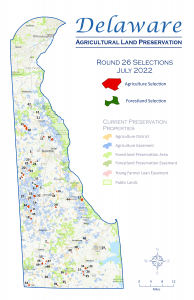HARRINGTON, Del. (July 28, 2022) — During a stop at the Delaware Agriculture Education & Commodities Building at the Delaware State Fair, Governor John Carney announced an additional 3,827 acres on 54 farms are now permanently preserved for future generations.
 2022 marks the 26th consecutive year of easement selections by the Delaware Agricultural Lands Preservation Foundation. In this round, three farms in New Castle County, 26 in Kent County, 23 in Sussex County were preserved, and two easements for forestland preservation.
2022 marks the 26th consecutive year of easement selections by the Delaware Agricultural Lands Preservation Foundation. In this round, three farms in New Castle County, 26 in Kent County, 23 in Sussex County were preserved, and two easements for forestland preservation.
“Preserving Delaware’s farmland is a priority and Delaware Aglands have helped keep farms in production,” said Governor Carney. “The Department of Agriculture has a big year ahead with $20 million allocated to preserve Delaware farms from the ground up. With this year’s average discount rate at 44%, there is no better time for farmers to consider preserving their farms for future generations. I want to thank members of the General Assembly for seeing the importance of protecting agriculture here in our state.”
Along with the state funding, Delaware’s success in preserving farmland would not be possible without the assistance of many county and federal partners. The Delaware Aglands Preservation Foundation has partnered with the USDA Natural Resources Conservation Service Agricultural Conservation Easement Program (ACEP), Sussex County Council, and Kent County Levy Court to purchase easements in this round. New Castle County provided funds this past winter to preserve a New Castle County farm that was not originally selected in Round 25.
“Farmland preservation is not just about preserving Delaware’s number one industry. It’s ensuring our residents have access to Delaware-grown food; that our next generation has a career in agriculture — no matter whether it’s on the farm, working in agribusiness, teaching agriscience to our youth, or developing the latest technology; and the heritage, culture, and beauty of rural Delaware can be enjoyed by residents and visitors alike,” said Secretary of Agriculture Michael T. Scuse. “In this round, nine easements in the Inland Bays watershed were selected, encompassing 486 acres. This is the most Inland Bays easements we have selected in one year and the most acres in the last twenty years. This is a big deal to ensure these communities have local farms providing them healthy food into the future.”
Since 1995, Delaware has preserved 6,873 acres of farmland in the Inland Bays watershed, costing $16.75 million. The easements selected in this year’s round have an estimated cost of $1.7 million. The only round with more acres preserved in this area was Round 5, announced in 2000.
“For the second year in a row, we have been able to accept every offer made by landowners to preserve their farms,” said Aglands Administrator Jimmy Kroon. “This is a significant change from several years ago when the process was much more competitive. Combined with increasing appraisals, we are paying more to preserve farmland, and we’re happy farmers are benefitting from that.”
The Delaware Agricultural Lands Preservation Foundation selects those farms approved for easement purchase using an impartial discounted ranking system that maximizes benefits for taxpayers. The Foundation does not own the land, but rather purchases landowners’ development rights and places a permanent agricultural conservation easement on the property. Landowners must first voluntarily enroll their farm into a 10-year preservation district and are eligible for permanent preservation the year after they apply. In addition to nearly 147,000 acres in permanent easements, Delaware’s Aglands Preservation Program has more than 34,000 acres of land enrolled in 10-year farmland preservation districts.
County governments can partner with the state program and add county funds to select properties in their areas, leveraging state resources for the most significant impact.
Delaware’s statewide program made its first round of easement purchases in 1996 and has since preserved 21 percent of New Castle County farmland, 38 percent of Kent County farmland, and 18 percent of Sussex County farmland.
Delaware farmers interested in preserving their farms should be sure they meet the following eligibility requirements:
• Property must be zoned for agriculture and not subject to any major subdivision plan.
• The property meets the minimum Land Evaluation and Site Assessment (LESA) score of 170. LESA is a process that attempts to estimate the farm’s long-term viability based on the farm’s soil productivity and the land use and agriculture infrastructure on and around the farm. Scores range from 0-300. Aglands program staff calculate the LESA score when applications are received.
• The property has to meet the state’s Farmland Assessment Act (10 acres or more which generate at least $1,000 in agricultural sales annually; farms under 10 acres which create at least $10,000 annually in agricultural sales).
• Farms of 200 acres or more constitute an agricultural district.
• Farms under 200 acres can enter the program if they are within 3 miles of an existing agricultural district. With over 1,154 farms already preserved, it is rare that a farm under 200 acres does not meet these criteria.
Entirely forested properties in managed timber production can also enroll in the Forestland Preservation Program, which purchases Forestland Preservation Easements through a similar process as Aglands Preservation.
For new farms interested in preservation, the deadline to apply and be eligible for Round 27 is October 31, 2022. For more information, visit https://de.gov/aglands.
The Delaware Agricultural Lands Preservation Foundation’s Board of Trustees includes representatives from agriculture and state agencies. Trustees are Mark Collins, chairman; James G. Vanderwende, vice-chairman; Janice Truitt, treasurer; William H. “Chip” Narvel Jr., secretary; Secretary of Agriculture Michael T. Scuse; State Treasurer Colleen C. Davis; Secretary of Natural Resources and Environmental Control Shawn Garvin; Peter Martin; Theodore P. Bobola Jr.; Robert Emerson; and H. Grier Stayton.
###